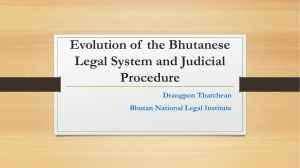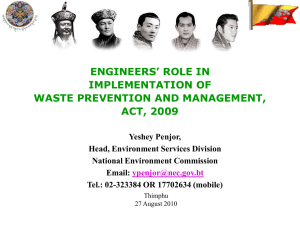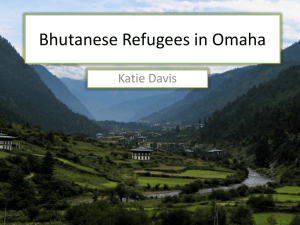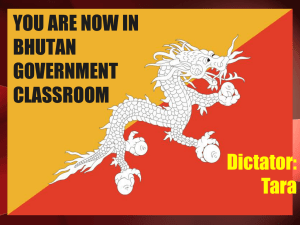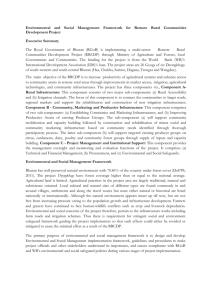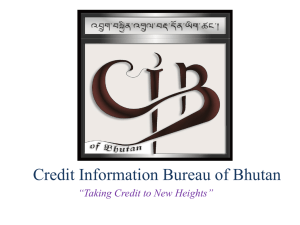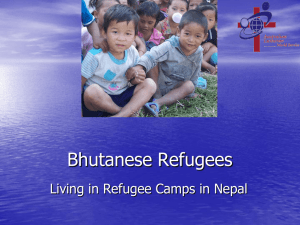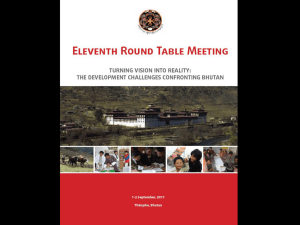EMBASSY OF INDIA THIMPHU . . . India
advertisement
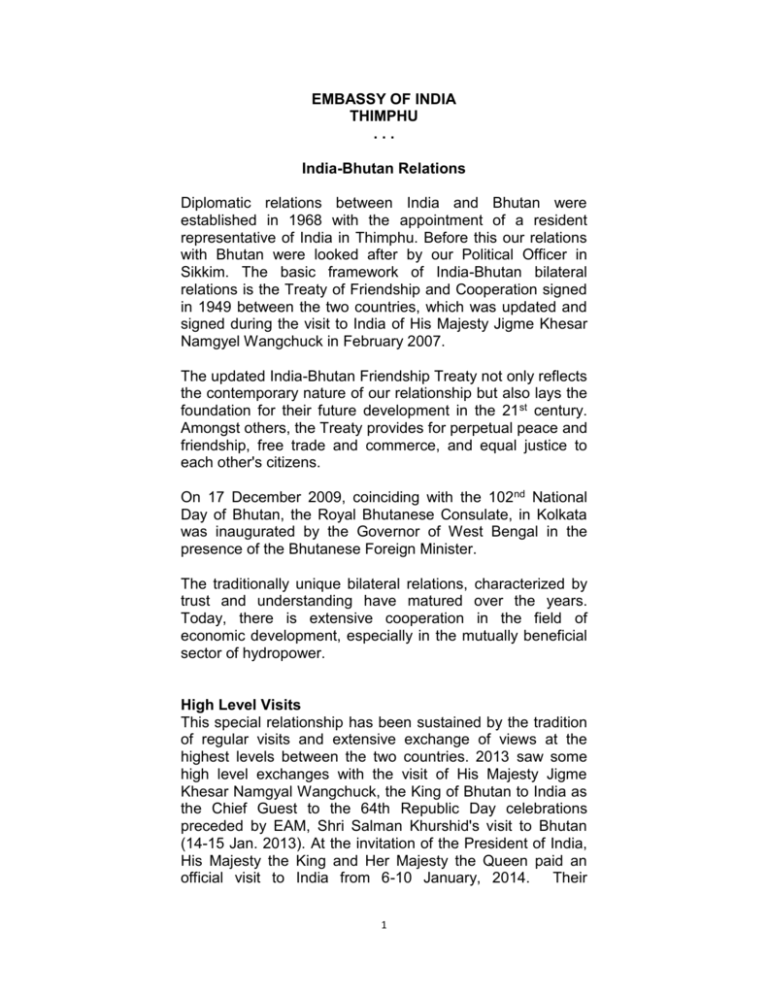
EMBASSY OF INDIA THIMPHU ... India-Bhutan Relations Diplomatic relations between India and Bhutan were established in 1968 with the appointment of a resident representative of India in Thimphu. Before this our relations with Bhutan were looked after by our Political Officer in Sikkim. The basic framework of India-Bhutan bilateral relations is the Treaty of Friendship and Cooperation signed in 1949 between the two countries, which was updated and signed during the visit to India of His Majesty Jigme Khesar Namgyel Wangchuck in February 2007. The updated India-Bhutan Friendship Treaty not only reflects the contemporary nature of our relationship but also lays the foundation for their future development in the 21 st century. Amongst others, the Treaty provides for perpetual peace and friendship, free trade and commerce, and equal justice to each other's citizens. On 17 December 2009, coinciding with the 102nd National Day of Bhutan, the Royal Bhutanese Consulate, in Kolkata was inaugurated by the Governor of West Bengal in the presence of the Bhutanese Foreign Minister. The traditionally unique bilateral relations, characterized by trust and understanding have matured over the years. Today, there is extensive cooperation in the field of economic development, especially in the mutually beneficial sector of hydropower. High Level Visits This special relationship has been sustained by the tradition of regular visits and extensive exchange of views at the highest levels between the two countries. 2013 saw some high level exchanges with the visit of His Majesty Jigme Khesar Namgyal Wangchuck, the King of Bhutan to India as the Chief Guest to the 64th Republic Day celebrations preceded by EAM, Shri Salman Khurshid's visit to Bhutan (14-15 Jan. 2013). At the invitation of the President of India, His Majesty the King and Her Majesty the Queen paid an official visit to India from 6-10 January, 2014. Their 1 Majesties expressed their appreciation to the President for inviting them to be the first guest at the refurbished guest wing of the Rashtrapati Bhawan. In the first overseas visit after being elected Prime Minister, Lyonchhen Tshering Tobgay (PMTT) visited India from 30 August to 4 September, 2013. It was his first official visit to India. He was accompanied by his wife and Foreign Minister among other senior RGOB officials. PMTT met with the President, Vice President and the Prime Minister and other Ministers and dignitaries. During the visit, GOI assistance package for Bhutan’s 11th Five Year Plan was agreed upon. PMTT also visited Hyderabad during his stay in India. For the swearing-in ceremony of PM-designate Narendra Modi, PMTT along with 6-member delegation which included Foreign Minister visited India from 25-28 May, 2014. He had bilateral meetings with PM Narendra Modi and the President, besides interactions with other senior officials. Prime Minister of India Shri Narendra Modi visits Bhutan from 15-16 June, 2014 At the invitation of the King of Bhutan (K5), Prime Minister Modi paid a State Visit to Bhutan from 15 – 16 June, 2014. He was accompanied by EAM, NSA and FS among other senior officials. It was his first visit abroad after he was sworn in as Prime Minister of India. The visit reinforced the tradition of regular high level exchanges between the two countries. During the visit, PM Modi had audience with K5 and K4 and meeting with PMTT. The Opposition Leader called on PM Modi. He also addressed the Joint Session of Bhutanese Parliament on 16th June, 2014. During the visit, he laid the foundation stone of 600 MW Kholongchu Hydropower Project and inaugurated the Supreme Court building which was constructed with GOI assistance. Besides exchanging views and discussing bilateral relations and economic cooperation, PM Modi announced doubling of Nehru Wangchuck Scholarship to Rs. 2 crores per year. He also announced GOI’s assistance for establishment of ELibrary in the National Library of Bhutan and in all the 20 districts of Bhutan. The two sides agreed to continue close coordination and cooperation in areas relating to their national interests and not allow each other’s territory to be used for interests inimical to the other. This high profile visit was covered prolifically by media in Bhutan. Bhutan felt honoured that PM Narendra Modi chose Bhutan for his first visit and ensured that he was received warmly. PM 2 Narendra Modi commented, “this Bhutan trip will remain etched in my memory; it was a very satisfying and productive visit”. Economic Cooperation Mutually beneficial economic linkages between India and Bhutan have been an important element in our bilateral relations. India continues to be the largest trade and development partner of Bhutan. Planned development efforts in Bhutan began in the early 1960s. The First Five Year Plan (FYP) of Bhutan was launched in 1961. Since then, India has been extending financial assistance to Bhutan’s FYPs. The 10th FYP ended in June 2013. India's overall assistance to the 10th FYP was a little over Rs. 5000 crores, excluding grants for hydropower projects. Hydropower Cooperation Hydropower is one of the main pillars of bilateral cooperation. Three hydro-electric projects (HEPs) totaling 1416 MW, (336 MW Chukha HEP, the 60 MW Kurichu HEP, and the 1020 MW Tala HEP), are already exporting electricity to India. In 2008 the two governments agreed to further develop a minimum of 10,000 MW hydropower generation capacity by 2020 and identified ten more projects. Of these, three projects totaling 2940 MW (1200 MW Punatsangchu-I, 1020 MW Punatsangchu-II and 720 MW Mangdechu HEPs) are under construction and are scheduled to be commissioned in the last quarter of 20172018. Out of the remaining 7 HEPs, 4 totaling 2120 MW (600 MW Kholongchhu, 180 MW Bunakha, 570 MW Wangchu and 770 MW Chamkarchu) will be constructed under Joint Venture model. A Framework IG agreement has been signed between both the Governments on 22.04.14 for these JV HEPs. DGPC and SJVNL, JV partners for Kholongchhu HEP signed a MoU for carrying out pre-construction activities; the stakeholders Agreement is under active discussion. Prime Minister Narendra Modi during his visit to Bhutan in June 2014 laid the foundation stone of Kholongchhu HEP on 16.06.14.Two identified hydropower projects of Kuri-Gongri (2640MW) and Sankosh (2560MW), will be implemented under the IG model. Cooperation in the hydropower sector between our two countries is a true example of mutually beneficial relationship. Power is an important sector of Bhutanese economy.It contributes 12% to the GDP.It is the most important export 3 item contributing 32% (Nu 9.7 bn) of Bhutan's total exports (Nu 2970 cr.).Druk Green Power Corporation, which controls all electricity generation plants of the country, is the highest tax payer of the country. Eleventh Five –Year Plan (2013-18): The highlight of the first session of the National Assembly was the approval of the 11th Five Year Plan. The Plan has a total budget outlay of Nu.213 billion, with self-reliance and inclusive green socio-economic development as the key objectives. Government of India committed to support Bhutan’s 11th Five Year Plan to the tune of Rupees 45 billion – Rs. 28 billion as Project Ties Assistance (PTA) Rs. 8.5 billion for Small Development Projects (SDP) and Rs. 8.5 billion as Programme Grant / Development Subsidy. There was also a commitment for an additional Rupees 5 billion for the Economic Stimulus Plan. In the 2nd Plan Talks, GOI has agreed to support 40 PTA projects worth Rs. 818.18 crores. In the SDP Committee meeting held in March 2014, GOI has agreed to support 59 SDPs worth Rs. 183.53 crores. Standby Credit Facility: GoI extended a standby credit facility of Rs 1000 crores to RGoB to help Bhutan overcome the rupee liquidity crunch. This Credit Facility was provided at a concessional interest rate of 5% per annum. It is valid for 5 years. Trade with India India is Bhutan's largest trading partner. A free trade regime exists between India and Bhutan. The India-Bhutan Trade and Commerce Agreement was first signed in 1972. It was last renewed 2006 for a period of 10 years; it comes up for review next in 2016. The Agreement also provides for duty free transit of Bhutanese merchandise for trade with third countries. During 2012, bilateral trade reached Rs.6960 Cr. Imports from India were Rs. 4180 cr., accounting for 79.4% of Bhutan's total imports. Bhutan's exports to India stood at Rs. 2780 cr. (including electricity) and constituted 94% if its total exports. Total bilateral trade grew by about 13% in 2012. 2009 Particulars 4 2010 2011 2012 Exports to Bhutan 1984 (Imports from India)(Rs. Cr) Exports to Bhutan from 77.7% India as a % to total Bhutanese import Imports from 2241 Bhutan(Exports to India) (Rs. Cr) Imports from Bhutan to 93.5% India as a % to total Bhutanese export 2930 3520 4180 75.1% 72.3% 79.4% 2600 2640 2780 88.7% 83.8% 93.9% Major items of exports from Bhutan to India are electricity, ferro-alloys, carbides, Bar & rods, Copper wire, Dolomite, Gypsum, Agri products (oranges, cardamom, potatoes).Major exports from India to Bhutan are High Speed Diesel, ferrous products, Motor Spirit including aviation spirit (petrol), Copper wire, Rice, Wheat Flour, Wood Charcoal, Hydraulic turbines, machinery items, Coke and semi coke of coal, soyabean oil, milk Powder etc. Several important economic and commercial conferences and trade fairs and exhibitions have been held in Bhutan and in India to further bilateral economic and commercial relations. Educational and Cultural Cooperation There is close bilateral cooperation in the educational and cultural fields between India and Bhutan. Government of India scholarships are granted to Bhutanese students at undergraduate and post graduate levels every year in Indian institutions of higher learning. Several hundred Bhutanese students are studying in India under these two schemes. In addition, under the Nehru Wangchuck Scholarship Scheme (implemented in 2010) and under the new Bhutan ICCR Scholarship Scheme (implemented in 2012) 67 Bhutanese students are undergoing graduate/post graduate courses in India. For the academic session 2014-15, 89 Undergraduate scholarships and 20 Bhutan ICCR Scholarship nominees have been selected and are in the process of getting placed in various educational institutions in India. Ambassador’s scholarships are granted to deserving Bhutanese self financing students 5 studying in India. In the past ten years, more than 3000 Bhutanese students have benefited from the Ambassador’s Scholarship Scheme. Ten slots every year are being provided at Sainik Schools in India for Bhutanese students of the 6th Std level. The entire cost of their studies in the Sainik School upto 12th Std is borne by the Government of India. Three Lecturers from India are on deputation in two colleges of the Royal University of Bhutan under the TCS Colombo Plan. The request of RGoB for a further 27 Lecturers from India under this scheme is under process in MEA. Through the ITEC Programme (220 slots) and the Technical Cooperation Scheme of the Colombo Plan (60 slots) were provided to Bhutan in the CFY 2013-14 for upgrading administrative and technical skills of Government/SemiGovernment/Private Sector Employees out of which 269 slots were utilized by Bhutan. India-Bhutan Foundation India-Bhutan Foundation was established in August 2003 during the visit of the present King (then Crown Prince) to India with the aim of enhancing people to people exchanges in focus areas like education, culture and environment protection. Ambassador of Bhutan and India are the Co-Chairpersons of the Foundation. The Royal Government of Bhutan and the Government of India have contributed Rs. 5 Crore each as main corpus fund to IBF and the entire amount of Rs.10 Crores has been kept in a fixed deposit in Bhutan. Interest earned from the fixed deposit is used for financing proposals received from Bhutanese/Indian citizens and Non Governmental Organisations on studies, research, and similar activities, exchanges of a cultural/educational/scientific nature, programmes and activities such as seminars, work shops on subjects of common mutual interest etc. that can help in achieving the objectives of the Foundation. The 13th Board of Directors Meeting was held in Delhi on 19th December, 2013. The 14th Board of Directors Meeting is scheduled to take place in Thimphu in the latter part of 2014. There is vibrant cultural exchanges between the two countries. Nehru Wangchuck Cultural Centre is abuzz with cultural activities around the year. Mountain Echo, a literary festival is organized in Bhutan every year. The 5th edition of the Mountain Echoes Literary Festival, co-sponsored by the India-Bhutan Foundation was organized in Thimphu from 216 24 May, 2014. Energy Minister from Rajasthan Gajendra Singh also participated in the event. The three-day Festival featured a mix of Bhutanese, Indian and international writers, film makers, musicians and artists. Indian Community There are about 56,000 Indian nationals living in Bhutan, employed mostly in hydro-electric projects and construction and roads industry. In addition, between 8000 and 10,000 day workers come into Bhutan everyday to work in border towns. 25 June 2014 7
